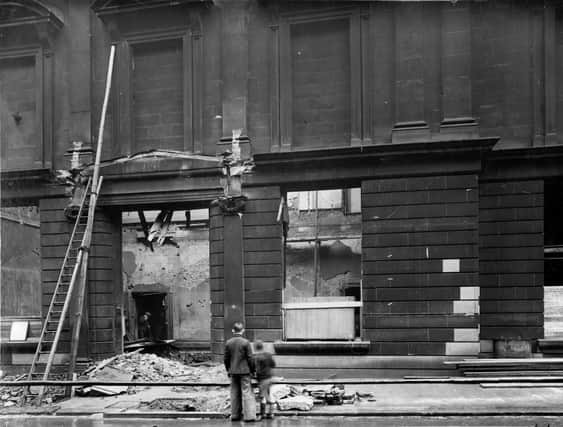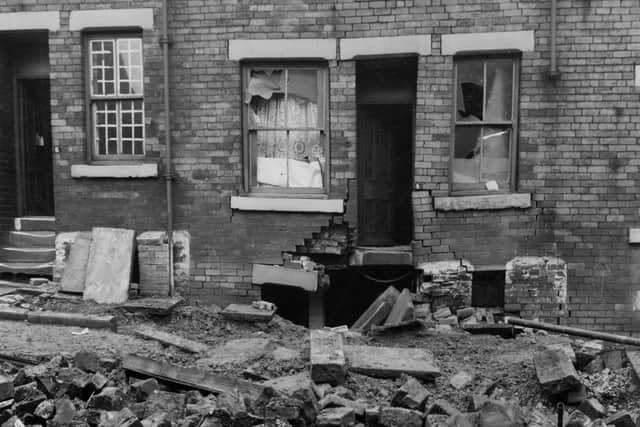80 years on: Plotting the horror of Nazi ‘Blitz’ on Leeds


Some 65 people are thought to have died and 258 were injured as a direct result of the raid on March 14, 1941. But the full details were never published, and the passing years have made them even more obscure.
It has taken some of the city’s present-day students to plot the precise locations of the hits, and to mark the anniversary they have published their findings on a website.
Advertisement
Hide AdAdvertisement
Hide AdAround 25 tons of explosives were dropped on Leeds that night, with the gas works and industrial areas surrounding the River Aire taking the brunt of the force. The bombs also damaged the Town Hall, city museum, telephone exchange and many private homes. More than 100 separate fires were reported, with damage to 4,500 buildings.


“Leeds has caught it at last,” some were heard to remark.
The Germans had blitzed Sheffield three months earlier, with the loss of at least 660 people, and Hull was next in line. From March to July 1941, large scale raids over several nights there killed another 200 people.
“Though not as badly bombed as other places, we were all struck by how little had been written about Leeds,” said Dr Henry Irving, senior lecturer in public history at Leeds Beckett University, which led the research in partnership with other public bodies.
His team used previously classified security reports, genealogy databases and historical maps to piece together the full story of West Yorkshire’s night on the front line.
Advertisement
Hide AdAdvertisement
Hide AdThe Government’s brief confirmation that the raid had taken place begged more questions than it answered. In reality, the city was thrown into turmoil, with the geographical spread of the attacks – from Weetwood in the north to Beeston in the south – stretching the emergency services to the limit. A mixture of incendiary, high explosive and delayed action bombs were dropped as far afield as Castleford and Holmfirth, but the damage to the phone exchange meant reports from the sites were delayed. The greatest impact was on the industrial areas of Holbeck, Armley, Lower Wortley and the railway land between Wellington Street and Wellington Road.
But the official reports of casualties represented less than one-fifth of the actual numbers.
The statistics also concealed countless human tragedies, Dr Irving said. “The students worked to connect individual incidents with the people affected, adding details about the legacies of the raid,” he said. “The subject matter was quite emotional.”
English and history student Leanne Speight said she remembered having heard stories of the raids from her great grandmother, who worked in a munitions factory.
Advertisement
Hide AdAdvertisement
Hide Ad“She was one of hundreds of thousands of women across Britain who did their bit and it was clear she viewed her contribution as nothing out of the ordinary.
“Reports published afterwards show women did not hesitate to tackle fires caused by incendiary bombs, even when high explosives were falling nearby. Many of these women worked in roles where such actions would not have been expected of them,” she said.
The greatest single loss of life during the raid was at the city’s famous Kirkgate Market, where a combination of incendiary and high explosive bombs were dropped at around 1.45am.
One bomb destroyed a brick air raid shelter and warden’s post outside the market, killing six civilians and two air raid wardens, but the details were withheld.
Advertisement
Hide AdAdvertisement
Hide AdAnother bomb caused a fire in the main market building. The Yorkshire Post reported that stallholders and the manager of the nearby swimming baths helped to pump water from the pool on to the fire.
Part of the market was closed the next day but reopened the following Monday.
The Leeds raids website is at www.leedsbeckett.ac.uk/leedsblitz.
Support The Yorkshire Post and become a subscriber today. Your subscription will help us to continue to bring quality news to the people of Yorkshire. In return, you’ll see fewer ads on site, get free access to our app and receive exclusive members-only offers. Click here to subscribe.
Comment Guidelines
National World encourages reader discussion on our stories. User feedback, insights and back-and-forth exchanges add a rich layer of context to reporting. Please review our Community Guidelines before commenting.